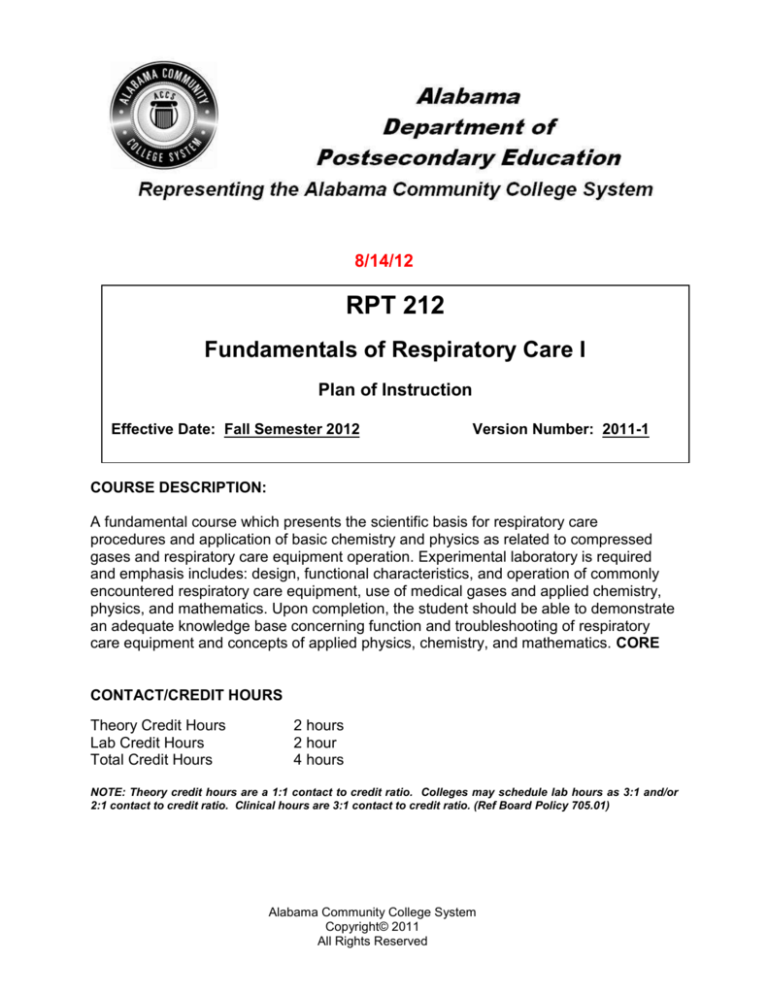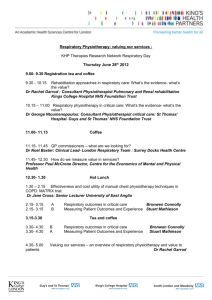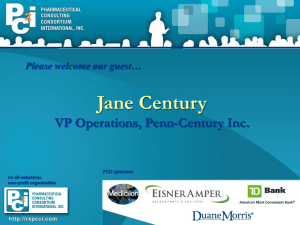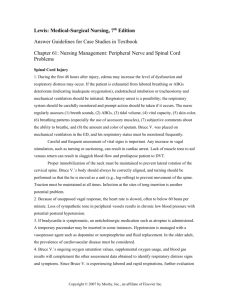
8/14/12
RPT 212
Fundamentals of Respiratory Care I
Plan of Instruction
Effective Date: Fall Semester 2012
Version Number: 2011-1
COURSE DESCRIPTION:
A fundamental course which presents the scientific basis for respiratory care
procedures and application of basic chemistry and physics as related to compressed
gases and respiratory care equipment operation. Experimental laboratory is required
and emphasis includes: design, functional characteristics, and operation of commonly
encountered respiratory care equipment, use of medical gases and applied chemistry,
physics, and mathematics. Upon completion, the student should be able to demonstrate
an adequate knowledge base concerning function and troubleshooting of respiratory
care equipment and concepts of applied physics, chemistry, and mathematics. CORE
CONTACT/CREDIT HOURS
Theory Credit Hours
Lab Credit Hours
Total Credit Hours
2 hours
2 hour
4 hours
NOTE: Theory credit hours are a 1:1 contact to credit ratio. Colleges may schedule lab hours as 3:1 and/or
2:1 contact to credit ratio. Clinical hours are 3:1 contact to credit ratio. (Ref Board Policy 705.01)
Alabama Community College System
Copyright© 2011
All Rights Reserved
Fundamentals of Respiratory Care I
RPT 212
PREREQUISITE COURSES
As determined by college.
CO-REQUISITE COURSES
As determined by college.
PROFESSIONAL COMPETENCIES
Describe the physical characteristics and related gas laws of medical gas as
related to therapeutic devices used in respiratory care practice.
Perform methods and procedures to prevent infection.
Discuss the importance of obtaining an accurate medical history and patient
assessment.
Describe the indications, goals, clinical objectives, complications and hazards
associated with medical gas therapy.
Describe the proper assembly and function of medical gas delivery devices,
storage methods, and safety mechanisms.
Describe the proper assembly and usage of aerosol delivery devices.
Describe the proper use of humidity and bland aerosol therapy as they apply to
the respiratory system.
Discuss the rationale of implementing and evaluating lung expansion therapy.
INSTRUCTIONAL GOALS
Cognitive – Comprehend principles and concepts related to respiratory care.
Psychomotor – Apply principles of respiratory care.
Affective – Value the importance of adhering to policy and procedures related to
respiratory care.
STUDENT OBJECTIVES
Condition Statement: Unless otherwise indicated, evaluation of student’s attainment
of objectives is based on knowledge gained from this course. Specifications may be in
the form of, but not limited to, cognitive skills diagnostic instruments, manufacturer’s
specifications, technical orders, regulations, national and state codes, certification
agencies, locally developed lab/clinical assignments, or any combination of
specifications.
ACCS Copyright© 2012
All Rights Reserved
2
Fundamentals of Respiratory Care I
RPT 212
STUDENT LEARNING OUTCOMES
MODULE A – PHYSICAL PRINCIPLES IN RESPIRATORY CARE
MODULE DESCRIPTION – The purpose of this module is to teach the students the
foundational principles of medical gases and related delivery devices. Topics include heat,
energy, thermodynamics, states of matter, fluid dynamics and the Bernoulli effect.
PROFESSIONAL COMPETENCIES
PERFORMANCE OBJECTIVES
KSA
A1.0 Describe the physical
A1.1 This module is measured
2
characteristics and related gas
cognitively.
laws of medical gas as related
to therapeutic devices used in
respiratory care practice.
LEARNING OBJECTIVES
A1.1.1 Explain the three common temperature scales and the conversion
process.
A1.1.2 Discuss heat transfer and the effects of water vaporization.
A1.1.3 Describe the properties that characterize the three states of matter.
A1.1.4 Describe gas behavior under changing conditions.
A1.1.5 Describe the principles of flow and fluid dynamics.
MODULE A OUTLINE:
KSA
2
2
2
2
2
States of Matter
o Internal energy of matter
o Heat and the First Law of Thermodynamics
o Heat transfer
Conduction
Convection
Radiation
Evaporation and condensation
o Laws of thermodynamics
Internal energy and temperature
Absolute zero
Temperature scales
Change of State
o Liquid–solid phase changes (melting and freezing)
Melting
Freezing
o Properties of liquids
Pressure in liquids
Buoyancy (Archimedes' Principle)
Viscosity
Cohesion and adhesion
Surface tension
Capillary action
ACCS Copyright© 2012
All Rights Reserved
3
Fundamentals of Respiratory Care I
RPT 212
Liquid–Vapor Phase Changes
o Boiling
o Evaporation, vapor pressure, and humidity
Influence of temperature
Humidity
Properties of Gases
o Kinetic activity of gases
o Molar volume and gas density
Molar volume
Density
Gaseous diffusion
Gas pressure
Measuring atmospheric pressure
Clinical pressure measurements
o Partial pressures (Dalton's Law)
o Solubility of gases in liquids (Henry's Law)
Gas Behavior Under Changing Conditions
o Gas laws
o Effect of water vapor
Corrected pressure computations
Correction factors
o Properties of gases at extremes of temperature and pressure
o Critical temperature and pressure
Fluid Dynamics
o Pressures in flowing fluids
o Patterns of flow
Laminar flow
Turbulent flow
Transitional flow
o Flow, velocity, and cross-sectional area
o The Bernoulli Effect
o Fluid entrainment
o The Venturi and pitot tubes
o Fluidics and the Coanda effect
MODULE B – INFECTION CONTROL
MODULE DESCRIPTION – The purpose of this module is to teach the students the
methods and procedures for infection control. Topics include clean and aseptic
techniques, disease prevention, and standard/universal precautions.
ACCS Copyright© 2012
All Rights Reserved
4
Fundamentals of Respiratory Care I
RPT 212
PROFESSIONAL COMPETENCIES
PERFORMANCE OBJECTIVES
B1.0 Perform methods and
B1.1 Demonstrate appropriate hand
procedures to prevent infection.
washing techniques designed to
prevent infection.
B1.1
Demonstrate appropriate use of
PPE according to patient
conditions and procedures.
LEARNING OBJECTIVES
B1.1.1 Identify the pathogens associated within the health care environment.
B1.1.2 Describe strategies to prevent the spread of infection in the hospital.
B1.1.3 Identify and describe the appropriate use of PPE according to patient
conditions and procedures.
B1.1.4 Describe equipment handling procedures.
MODULE B OUTLINE:
KSA
3
3
KSA
2
2
2
2
Spread of Infection
o Sources of infectious agents
o Susceptible hosts
o Modes of transmission
Contact transmission
Droplet transmission
Airborne transmission
Miscellaneous types of aerosol transmission
Other sources of infection not involving person-to-person
transmission
Infection Prevention Strategies
o Creating a safe culture
o Decreasing host susceptibility
o Eliminating the source of pathogens
o Interrupting routes of transmission
o Standard precautions
o Hand hygiene
o Gloves
o Mouth, nose, eye, and face protection
o Respiratory protection
o Gowns, aprons, and protective apparel
o Transmission-based precautions
o Airborne infection isolation
o Protective environment
o Patient placement
o Transport of infected patients
Disinfection and Sterilization
o Spaulding approach to disinfection and sterilization of patient care
equipment
ACCS Copyright© 2012
All Rights Reserved
5
Fundamentals of Respiratory Care I
RPT 212
o Cleaning
o Disinfection
Chemical disinfection
o Sterilization
Steam sterilization
Flash sterilization
Low-temperature sterilization technologies
Equipment Handling Procedures
o Maintenance of in-use equipment
Nebulizers
Ventilators and ventilator circuits
Bag-mask devices
Suction systems
Oxygen therapy apparatus
Pulmonary function equipment
Other respiratory care devices
o Processing reusable equipment
Respiratory care equipment
o Disposable equipment
o Fluids and medications precautions
o Handling contaminated articles and equipment
o Using needles and syringes
o Handling laboratory specimens
MODULE C – PATIENT ASSESSMENT
MODULE DESCRIPTION – The purpose of this module is to teach the students how to
perform patient assessment and gather clinical laboratory data.
PROFESSIONAL COMPETENCIES
PERFORMANCE OBJECTIVES
KSA
C1.0 Discuss the importance of
C1.1 Obtain vital signs and recognize
3
obtaining an accurate medical
normal/abnormal values.
history and patient
assessment.
C1.1 Perform basic patient
3
assessment.
C1.1 Evaluate clinical laboratory data.
LEARNING OBJECTIVES
2
KSA
C1.1.1 Describe how to obtain vital signs and recognize normal/abnormal
values.
C1.1.2 Identify abnormalities in lung function associated with common
pulmonary symptoms.
C1.1.3 Describe the mechanisms responsible for normal and abnormal lung
sounds.
C1.1.4 Explain why it is necessary to examine the precordium, abdomen, and
extremities in a patient with cardiopulmonary disease.
2
ACCS Copyright© 2012
All Rights Reserved
6
2
2
2
Fundamentals of Respiratory Care I
RPT 212
C1.1.5 Describe how to collect and evaluate clinical laboratory data.
MODULE C OUTLINE:
2
Interviewing the Patient and Taking a Medical History
o Principles of interviewing
Structure and technique for interviewing
o Common cardiopulmonary symptoms
Dyspnea
Breathlessness
Positional dyspnea
The language of dyspnea
Assessing dyspnea in the interview
Psychogenic dyspnea: panic disorders and hyperventilation
Cough
Sputum production
Hemoptysis
Chest pain
Fever
Pedal edema
o Format for the medical history
Physical Examination
o General appearance
o Level of consciousness
o Vital signs
Body temperature
Pulse rate
Electrocardiography(12-lead ECG)
Respiratory rate
Blood pressure
Examination of the head and neck
Head
Neck
o Examination of the thorax and lungs
Inspection
Thoracic configuration
Breathing pattern and effort
Palpation
Vocal and tactile fremitus
Thoracic expansion
Skin and subcutaneous tissues
Percussion of the chest
Percussion over lung fields
Clinical implications
Auscultation of the lungs
Stethoscope
ACCS Copyright© 2012
All Rights Reserved
7
Fundamentals of Respiratory Care I
RPT 212
Technique
Terminology
Mechanisms and significance of lung sounds
o Normal breath sounds
o Bronchial breath sounds
o Diminished breath sounds
o Wheezes and stridor
o Crackles
o Pleural friction rub
o Voice sounds
o Bronchophony
o Cardiac examination
Inspection and palpation
Auscultation of heart sounds
Abnormal heart sounds
o Abdominal examination
o Examination of the extremities
Clubbing
Cyanosis
Pedal edema
Capillary refill
Peripheral skin temperature
Skin color, degree of moisture, and turgor
MODULE D – MEDICAL GAS THERAPY
MODULE DESCRIPTION – The purpose of this module is to teach the students to
recognize the clinical indications, goals, hazards, and contraindications of medical gas
therapy. Topics include the use of oxygen, hyperbaric oxygenation, nitric oxide and heliox.
PROFESSIONAL COMPETENCIES
PERFORMANCE OBJECTIVES
KSA
D1.0 Describe the indications, goals, D1.1 Select and administer the
3
clinical objectives,
appropriate oxygen delivery
complications and hazards
device for the patient based on
associated with medical gas
clinical presentation.
therapy.
3
D1.1. Suggest/modify therapy based on
clinical assessment.
LEARNING OBJECTIVES
KSA
D1.1.1 Discuss the clinical indications and goals of oxygen therapy.
D1.1.2 Discuss the hazards and complications associated with oxygen therapy.
D1.1.3 Identify the appropriate oxygen delivery device for the patient based on
clinical presentation.
D1.1.4 Describe how to assess and modify oxygen therapy based on clinical
assessment.
D1.1.5 Describe how to implement and follow protocol based oxygen therapy.
3
2
3
ACCS Copyright© 2012
All Rights Reserved
8
3
2
Fundamentals of Respiratory Care I
RPT 212
D1.1.6 Discuss the use of other gas mixtures and applications as applied to the
cardiopulmonary patient.
MODULE D OUTLINE:
2
Oxygen Therapy
o General goals and clinical objectives
o Clinical practice guidelines
o Assessing the need for oxygen therapy
o Precautions and hazards of supplemental oxygen
Oxygen toxicity
Depression of ventilation
Retinopathy of prematurity
Absorption atelectasis
Fire hazard
Oxygen delivery systems: design and performance
o
Low-flow systems
Nasal cannula
Nasal catheter
Transtracheal catheter
o
Performance characteristics of low-flow systems
o
Troubleshooting low-flow systems
o
Reservoir systems
Reservoir cannula
Reservoir masks
Non-rebreathing reservoir circuit
Troubleshooting reservoir systems
o
High-flow systems
Principles of gas mixing
Air-entrainment systems
Air-entrainment (Venturi) mask
Air-entrainment nebulizer
Troubleshooting air-entrainment systems
Providing moderate to high FIO2 at high flow
Problems with downstream flow resistance
Blending systems
Mixing gases manually
Oxygen blenders
Enclosures
Oxygen tents
Hoods
Incubators
o
Other oxygen delivery devices
High-flow nasal cannula
Bag-mask devices
Demand- flow and pulse-dose systems
Selecting a delivery approach
ACCS Copyright© 2012
All Rights Reserved
9
Fundamentals of Respiratory Care I
RPT 212
Purpose
Patient
Performance
General goals and patient categories
Protocol-based oxygen therapy
Hyperbaric Oxygen Therapy
o Physiologic effects
o Methods of administration
o Indications
Air embolism
Carbon monoxide poisoning
o Complications and hazards
o Troubleshooting
Other Medical Gas Therapies
o Nitric oxide therapy
Mode of action
Indications
Dosing
Toxicity and adverse effects
Methods of administration
Withdrawing therapy
o Helium-oxygen (heliox) therapy
Indications
Guidelines for use
Troubleshooting and hazards
o Carbon dioxide-oxygen (carbogen) therapy
MODULE E – STORAGE AND DELIVERY OF MEDICAL GASES
MODULE DESCRIPTION – The purpose of this module is to teach the proper procedures
of assembling, administering, troubleshooting and storing medical gases. Topics include
oxygen delivery devices, liquid and gaseous storage methods, and national safety
standards of medical gas transport and storage.
PROFESSIONAL COMPETENCIES
PERFORMANCE OBJECTIVES
KSA
E1.0 Describe the proper assembly
E1.1 Assemble and perform quality
3
and function of medical gas
assurance of medical gas delivery
delivery devices, storage
devices, including troubleshooting
methods, and safety
and correcting problems.
mechanisms.
LEARNING OBJECTIVES
E1.1.1 Distinguish between various gas supply systems.
E1.1.2 Describe how to assemble, check for proper function, and identify
malfunctions in various gas delivery systems.
E1.1.3 Differentiate between safety systems that apply to various equipment
connections.
ACCS Copyright© 2012
All Rights Reserved
KSA
2
3
2
10
Fundamentals of Respiratory Care I
RPT 212
MODULE E OUTLINE:
Characteristics of Medical Gases
o Oxygen (O2)
Characteristics
Production
Fractional Distillation
Physical Separation
o Air
o Carbon Dioxide (CO2)
o Helium (He)
o Nitric Oxide (NO)
o Nitrous Oxide (N2O)
Storage of Medical Gases
o Gas cylinders
Markings and identification
Cylinder sizes and content
Cylinder safety relief valves
Filling (charging) cylinders
Compressed gases
Liquefied gases
Measuring cylinder contents
Compressed gas cylinders
Liquid gas cylinders
Estimating the duration of cylinder gas flow
Estimating the duration of liquid oxygen cylinder gas flow
Gas cylinder safety
Cylinder storage
Cylinder transport
Cylinder use
o Bulk oxygen
Gas supply systems
Bulk oxygen safety precautions
Distribution and Regulation of Medical Gases
o Central piping systems
o Safety indexed connector systems
American standard safety system (ASSS)
Pin-index safety system (PISS)
Diameter-index safety system (DISS)
Quick-connect systems
o Regulating gas pressure and flow
High-pressure reducing valves
Preset reducing valve
Adjustable reducing valve
Multiple-stage reducing valve
ACCS Copyright© 2012
All Rights Reserved
11
Fundamentals of Respiratory Care I
RPT 212
Proper use of high-pressure reducing valves
Low-pressure gas flow meters
Flow restrictor
Bourdon gauge
Thorpe tube
MODULE F – Aerosol Drug Therapy
MODULE DESCRIPTION – The purpose of this module is to teach the proper assembly,
application, and troubleshooting of aerosol delivery devices.
PROFESSIONAL COMPETENCIES
PERFORMANCE OBJECTIVES
KSA
F1.0 Describe the proper assembly
F1.1 Assemble aerosol medication
3
and usage of aerosol delivery
delivery devices.
devices.
F1.1 Suggest/modify therapy based on
3
clinical assessment, including
troubleshooting.
LEARNING OBJECTIVES
F1.1.1 Describe how particle size, motion, and airway characteristics affect
aerosol deposition.
F1.1.2 Describe how to select the best aerosol drug delivery system for a given
patient.
F1.1.3 Describe how to initiate, assess, and modify aerosol drug therapy.
F1.1.4 Describe the benefits of assessment-based bronchodilator therapy
protocols.
F1.1.5 Describe how to protect patients and caregivers from exposure to
aerosolized drugs.
MODULE F OUTLINE:
KSA
2
3
3
2
3
Characteristics of Therapeutic Aerosols
o Aerosol output
o Particle size
o Deposition
Inertial impaction
Sedimentation
Diffusion
o Aging
o Quantifying aerosol delivery
Hazards of Aerosol Therapy
o Infection
o Airway reactivity
o Pulmonary and systemic effects
o Drug concentration
o Eye irritation
o Second-hand exposure to aerosol drugs
ACCS Copyright© 2012
All Rights Reserved
12
Fundamentals of Respiratory Care I
RPT 212
Aerosol Drug Delivery Systems
o Metered-dose inhalers
Breath-actuated pressurized metered dose inhaler (pMDI)
Dose counters
Factors affecting pMDI performance and drug delivery
Temperature
Nozzle size and cleanliness
Priming
Timing of actuation intervals
Aerosol delivery characteristics
Technique
pMDI accessory devices
Spacers and holding chambers
o Dry powder inhalers (DPIs)
Equipment design and function
Factors affecting the DPI performance and drug delivery
Intrinsic resistance and inspiratory flow rate
Exposure to humidity and moisture
Patient's inspiratory flow ability
Technique
o Nebulizers
Pneumatic (jet) nebulizers
Factors affecting nebulizer performance
o Nebulizer design
o Flow
o Gas source (hospital versus home)
o Humidity and temperature
o Characteristics of drug formulation
Small-volume nebulizers (SVNs)
o SVN with a reservoir
o Continuous small volume nebulizer with collection bag
o Breath-enhanced nebulizers
o Breath-actuated nebulizers
o Technique
o Infection control issues
Large-volume jet nebulizers
Hand-bulb atomizers and spray pumps
Ultrasonic nebulizers
o Large-volume ultrasonic nebulizers
o Small-volume ultrasonic nebulizers
Vibrating mesh nebulizers
New-generation nebulizers
o New nebulizer designs for liquids
o AERx®
o Respimat®
ACCS Copyright© 2012
All Rights Reserved
13
Fundamentals of Respiratory Care I
RPT 212
o Smart nebulizers
o Advantages and disadvantages of aerosol systems
o Special medication delivery issues for infants and children
o Selecting an aerosol drug delivery system
Assessment-Based Bronchodilator Therapy Protocols
o Sample protocol
o Assessing patient response
Use and limitations of peak flow monitoring
Other components of patient assessment
Dose-response assessment
Frequency of patient assessment
o Patient education
Special Considerations
o Acute care and off-label use
Continuous nebulization for refractory bronchospam
o Aerosol administration to mechanically ventilated patients
Use of a SVN during mechanical ventilation
Use of a vibrating mesh nebulizer during mechanical ventilation
Use of a pMDI during mechanical ventilation
o Aerosol generator placement
Placement during noninvasive ventilation
Placement during high-flow nasal oxygen
Placement during intrapulmonary percussive ventilation
Placement during high-frequency oscillatory ventilation
Controlling Environmental Contamination
o Negative pressure rooms
o Booths and stations
o Personal protective equipment
MODULE G – HUMIDITY AND BLAND AEROSOL THERAPY
MODULE DESCRIPTION – The purpose of this module is to teach the proper assembly,
application, and troubleshooting of humidity and bland aerosol therapy.
PROFESSIONAL COMPETENCIES
PERFORMANCE OBJECTIVES
KSA
G1.0 Describe the proper use of
G1.1 Apply humidity and bland aerosol
3
humidity and bland aerosol
therapy.
therapy as they apply to the
respiratory system.
G1.1 Suggest/modify therapy based on
3
clinical assessment, including
troubleshooting.
LEARNING OBJECTIVES
G1.1.1 Discuss the indications, contraindications, and hazards that pertain to
humidification and bland aerosol therapy.
G1.1.2 Discuss how to select the appropriate therapy to condition a patient's
inspired gas.
ACCS Copyright© 2012
All Rights Reserved
KSA
3
2
14
Fundamentals of Respiratory Care I
RPT 212
G1.1.3 Describe how to identify and resolve common problems associated with
humidification and bland aerosol therapy.
MODULE G OUTLINE:
3
Humidity Therapy
o Physiologic control of heat and moisture exchange
o Indications for humidification and warming of inspired gases
o Equipment
Physical principles governing humidifier function
Temperature
Surface area
Contact time
Thermal mass
Types of humidifiers
Active humidifiers
o Bubble
o Passover
o Vaporizer humidifiers
o Heat and moisture exchangers
o Active heat moisture exchangers (hmes)
Heating systems
Reservoir and feed systems
Manual systems
Automatic systems
Setting humidification levels
o Problem solving and troubleshooting
Condensation
Cross contamination
Proper conditioning of the inspired gas
Bland Aerosol Therapy
o Equipment for bland aerosol therapy
Aerosol generators
Large-volume jet nebulizers
Ultrasonic nebulizers
Airway appliances
Enclosures (mist tents and hoods)
o Sputum induction
o Problem solving and troubleshooting
Cross contamination
Environmental exposure
Inadequate aerosol output
Overhydration
Bronchospasm
ACCS Copyright© 2012
All Rights Reserved
15
Fundamentals of Respiratory Care I
RPT 212
MODULE H – LUNG EXPANSION THERAPY
MODULE DESCRIPTION – The purpose of this module is to teach the proper assembly,
application, and troubleshooting of lung expansion therapy equipment. Topics include the
various types of equipment used and patient assessment before, during, and after
therapy.
PROFESSIONAL COMPETENCIES
PERFORMANCE OBJECTIVES
KSA
H1.0 Discuss the rationale of
H1.1 Apply lung expansion therapy.
3
implementing and evaluating
lung expansion therapy.
3
H1.1 Suggest/modify therapy based on
clinical assessment, including
troubleshooting.
LEARNING OBJECTIVES
H1.1.1 Discuss the clinical findings seen in atelectasis and the impact of these
findings on the respiratory system.
H1.1.2 Discuss the indications, hazards, and complications associated with the
various modes of lung expansion therapy.
H1.1.3 Describe the primary responsibilities of the respiratory therapist in
planning, implementing, and evaluating lung expansion therapy.
MODULE H OUTLINE:
KSA
2
3
2
Causes and Types of Atelectasis
o Factors associated with causing atelectasis
Clinical Signs of Atelectasis
Lung Expansion Therapy
o Incentive spirometry
Physiologic basis
Indications
Contraindications
Hazards and complications
Equipment
Administration
Preliminary planning
Implementation
Follow-up
o Intermittent positive airway pressure breathing
Physiologic basis
Indications
Contraindications
Hazards and complications
Administration
Preliminary planning
Evaluating alternatives
Baseline assessment
Implementation
ACCS Copyright© 2012
All Rights Reserved
16
Fundamentals of Respiratory Care I
RPT 212
o Equipment preparation
o Patient orientation
o Patient positioning
o Initial application
o Adjusting parameters
Discontinuation and follow-up
Post-treatment assessment
Record keeping
Monitoring and troubleshooting
Machine performance
Patient response
o Positive airway pressure therapy
Physiologic basis
Indications
Contraindications
Hazards and complications
Equipment
Administering intermittent continuous positive airway pressure
Planning
Procedures
Monitoring and troubleshooting
ACCS Copyright© 2012
All Rights Reserved
17
Fundamentals of Respiratory Care I
RPT 212
LEARNING OUTCOMES TABLE OF SPECIFICATIONS
The table below identifies the percentage of learning objectives for each module.
Instructors should develop sufficient numbers of test items at the appropriate
level of evaluation.
Limited
Knowledge and
Proficiency
KSA
Module A
Module B
Module C
Module D
Module E
Module F
Module G
Module H
1
Moderate
Knowledge
and
Proficiency
2
100%
40%
40%
40%
40%
40%
40%
Advanced
Knowledge
and
Proficiency
3
Superior
Knowledge
and
Proficiency
4
60%
100%
60%
60%
60%
60%
60%
The KSA is NOT determined by the verb used in the learning objective, but rather in the context in which
the verb is used and the depth of knowledge and skills required.
Example: Three KSA levels using the same verb (describe):
KSA 1 – Describe three characteristics of metamorphic rocks. (simple recall)
KSA 2 – Describe the difference between metamorphic and igneous rocks. (requires cognitive
processing to determine the differences in the two rock types)
KSA 3 – Describe a model that you might use to represent the relationships that exist within the rock
cycle. (requires deep understanding of rock cycle and a determination of how best to represent it)
ACCS Copyright© 2012
All Rights Reserved
18
Fundamentals of Respiratory Care I
Indicator Key Terms
1
Limited
Knowledge
and
Proficiency
2
Moderate
Knowledge
and
Proficiency
3
Advanced
Knowledge
and
Proficiency
4
Superior
Knowledge
and
Proficiency
A
Affective
Objective
ACCS Copyright© 2012
All Rights Reserved
RPT 212
Learner’s Knowledge, Skills and Abilities
Description
Recognize basic information about the subject including terms
and nomenclature.
Students must demonstrate ability to recall information such as
facts, terminology or rules related to information previously
taught.
Performs simple parts of the competency. Student requires
close supervision when performing the competency.
Distinguish relationships between general principles and facts.
Adopts prescribed methodologies and concepts.
Students must demonstrate understanding of multiple facts
and principles and their relationships, and differentiate between
elements of information. Students state ideal sequence for
performing task.
Performs most parts of the competency with instructor
assistance as appropriate.
Examines conditions, findings, or other relevant data to select an
appropriate response.
The ability to determine why and when a particular response is
appropriate and predict anticipated outcomes.
Students demonstrate their ability to seek additional information
and incorporate new findings into the conclusion and justify their
answers.
Performs all parts of the competency without instructor
assistance.
Assessing conditions, findings, data, and relevant theory to
formulate appropriate responses and develop procedures for
situation resolution. Involves higher levels of cognitive
reasoning.
Requires students to formulate connections between relevant
ideas and observations.
Students apply judgments to the value of alternatives and select
the most appropriate response.
Can instruct others how to do the competency.
Performs competency quickly and accurately.
Describes learning objectives that emphasize a feeling tone, an
emotion, or a degree of acceptance or rejection.
Objectives vary from simple attention to selected phenomena to
complex but internally consistent qualities of character and
conscience.
Expressed as interests, attitudes, appreciations, values, and
emotional sets or biases.
19









